Medicine
The Death Test
It's officially known by the acronym CrisTAL (Criteria for Screening and Triaging to Appropriate Alternative Care), but it's more widely known as the Death Test. It's a 29-point checklist to help doctors determine if elderly patients are at risk of dying within the next three months. So, it seems like a more rigorous version of the "Surprise Question" which (as we've posted about before) is another test docs use to predict imminent death.More info: funeralwise.com
The Death Test:
1. Altered level of consciousness (Glasgow Coma Score change >2 or AVPU=P or U)
2. Blood pressure (a systolic blood pressure of less than 90 mm Hg)
3. Respiratory rate of more then five and less than 30
4. Pulse rate of less than 40 or more than 140
5. Need for oxygen therapy, or known oxygen saturation of less than 90 per cent
6. Hypolglaecemia blood glucose level (less sugar in the blood than normal)
7. Repeat or prolonged seizures
8. Low output of urine (less than 15 mL/h or less than 0.5 mL/kg/h) or a MEW or SEWS score of more than 4
9. Previous history of disease, including:
10. Advanced cancer
11. Kidney disease
12. Heart failure
13. Various types of lung diseases
14. Strokes and vascular dementia
15. Heart attack
16. Moderate to severe liver disease
17. Mental impairment such as dementia or disability from a stroke
18. Length of stay before this RRT call (>5 days predicts 1-year mortality)
19. Repeat hospitalisations in the past year
20. Repeat admission to the intensive care department of the hospital
21. Frailty
22. Unexplained weight loss
23. Self-reported exhaustion
24. Weakness (being unable to grip objects, being unable to handle objects or lift heavy objects of less than or equal to 4.5kg,
25. Slow walking speed (walks 4.5m in more than 7 seconds) or is
26. Inability to do physical exercise or stand
27. Is a nursing home resident or lives in supported accommodation
28. Having urine in their blood (more than 30mg albumin/g creatinine
29. Abnormal ECG (irregular heartbeat, fast heartbeat and any other abnormal rhythm or more than or equal to 5 ectopics/min and changes to Q or ST waves)
Posted By: Alex - Thu Jun 13, 2019 -
Comments (2)
Category: Death, Medicine
The Yips Phenomenon in Golf
The Yips are defined as "a disorder in which golfers complain of an involuntary movement — a twitch, a jerk, a flinch — at the time they putt or even when they chip. This interferes with their ability to perform that activity.” It was the subject of a multidisciplinary study by researchers at the Mayo Clinic, who concluded:The Yips should not be confused with the Yip Yips, which are something completely different:
Posted By: Alex - Wed May 15, 2019 -
Comments (0)
Category: Medicine, Sports, Golf
Home for Incurables
As late as 1952, "homes for incurables" were a going concern. Contemporary medicine seems to have abandoned the term "incurable" in favor of others that are perhaps less of a downer.
Source.
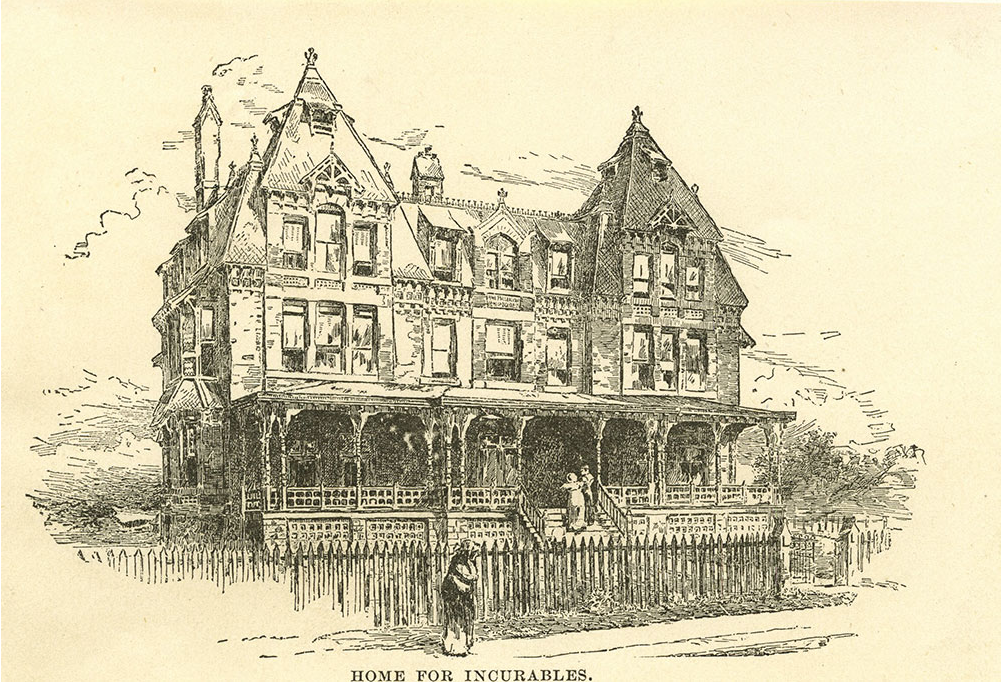
Source.

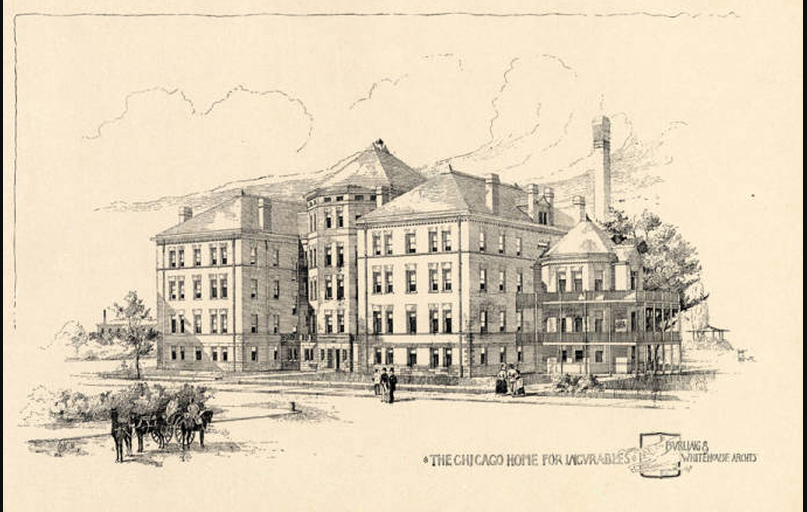
Posted By: Paul - Thu Jan 03, 2019 -
Comments (2)
Category: Architecture, Charities and Philanthropy, History, Medicine, Nineteenth Century, Twentieth Century
Chilling big toe cures runny nose
As reported by Israeli scientists Dr. Menahem Ram and Aladar Schwartz at a 1971 joint meeting of the Society for Cryobiology and the International Conference of Refrigeration:
Newport News Daily Press - Sep 3, 1971
Posted By: Alex - Thu Aug 16, 2018 -
Comments (6)
Category: Mad Scientists, Evil Geniuses, Insane Villains, Medicine, Cures for the common cold, Science, 1970s, Feet
Mat Fraser’s “Cabinet of Curiosities”
The explanation is here.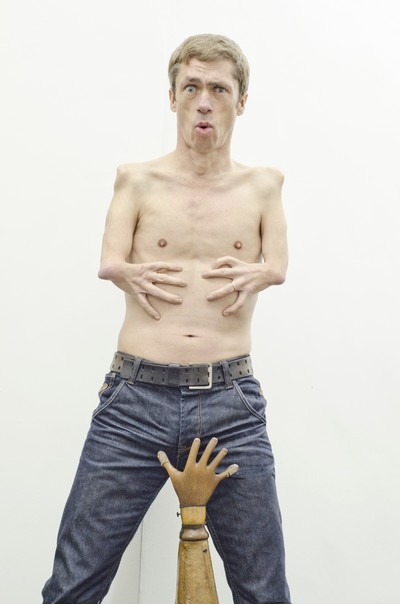

Posted By: Paul - Sat Aug 04, 2018 -
Comments (1)
Category: Body, Medicine, Museums, Performance Art, Twenty-first Century
New mask for seasickness
Dr. Richmond Goulden of the liner Lady Nelson models the latest in seasickness-prevention technology, 1939.The pipe adds a nice touch.
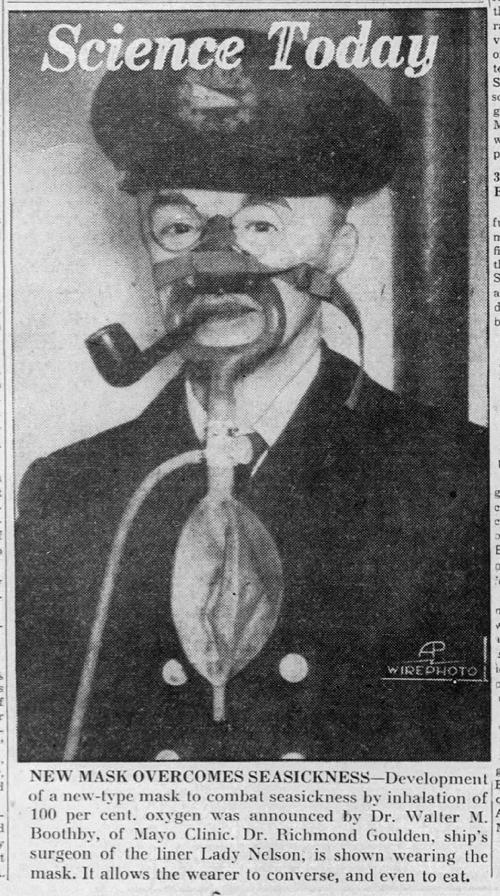
Baltimore Evening Sun - Jan 4, 1939
Posted By: Alex - Fri Jul 06, 2018 -
Comments (3)
Category: Inventions, Medicine, 1930s
Impact Therapy
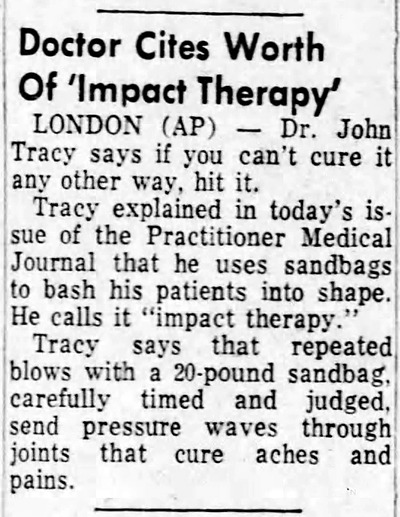
Shamokin News Dispatch - Aug 31, 1968
LONDON (AP) — Dr. John Tracy says if you can't cure it any other way, hit it.
Tracy explained in today's issue of the Practitioner Medical Journal that he uses sandbags to bash his patients into shape. He calls it "impact therapy."
Tracy says that repeated blows with a 20-pound sandbag, carefully timed and judged, send pressure waves through joints that cure aches and pains.
Posted By: Alex - Wed Jun 13, 2018 -
Comments (5)
Category: Health, Medicine, 1960s
Sneeze Girl
From Time magazine, Dec 14, 1936:To see if allergy to some substance caused the sneezing, Washington doctors scratched her skin some 80 times, rubbed into the scratches hay pollen, flower pollen, pulverized cat fur, dog hair, house dust, food extracts, dozens of substances.
Skin tests failed to reveal any specific allergy. A Washington doctor cut out the adolescent's tonsils, with no effect on the sneezing. Other specialists could find nothing unusual in her lungs or nervous system.
Lay cures for sneezing which Mary Cleer was urged to try included wearing a "magnetic" letter pinned to her night dress, looking down the bridge of her nose at pieces of bright silk held close to the tip, clipping an electrified wire to her nose and toes, getting tattooed, taking snuff.
Last week when Mary Cleer went to Johns Hopkins Hospital, the great medical faculty there had never before treated or even seen a girl who sneezed so persistently. Johns Hopkins specialists began a new series of tests. A psychiatrist examined the girl and summoned her parents to analyze their mental and emotional makeups. Mary underwent fluoroscopy, blood testing, other examinations. A gynecologist also took her in charge, for the nasal and genital tissues are histologically related. The mucous membranes of the nose swell during sexual excitement. This well-known phenomenon gives rise to a theory that the noses of many little girls become sensitive as they turn into young womanhood, and that this makes such girls sniff, lisp or pamper their noses in an apparently affected manner, and that this overture to womanhood causes an occasional girl to sneeze uncontrollably. That, a gynecologist might guess, was the trouble with Mary Cleer, 13.
Apparently the sneezing eventually stopped of its own accord. No one ever figured out what the cause was.
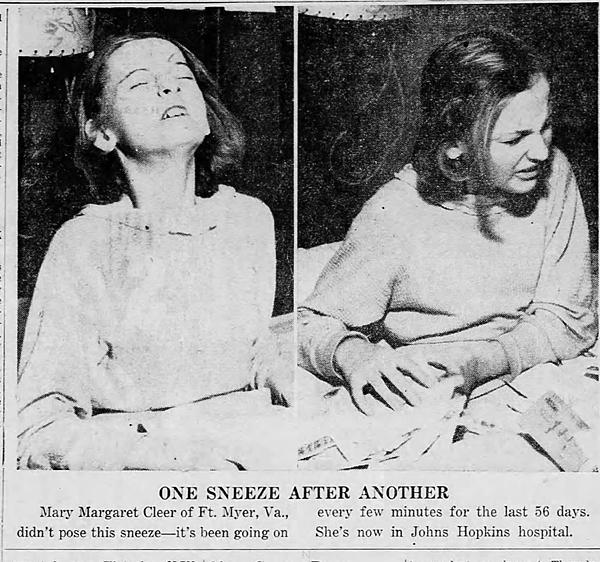
Decatur Daily Review - Dec 3, 1936
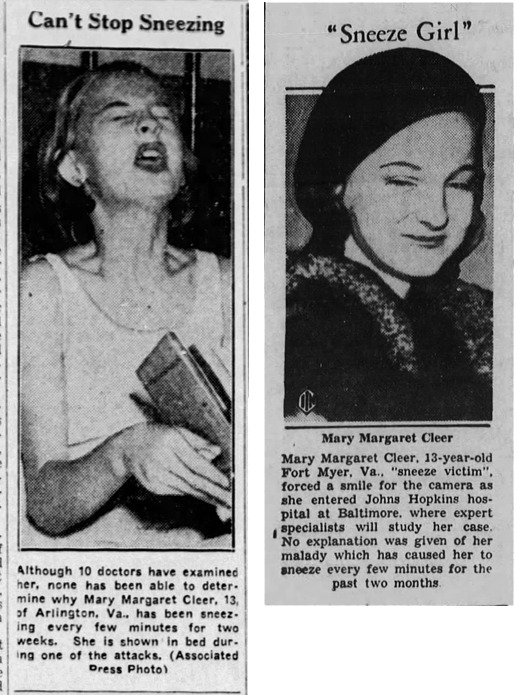
(left) Alexandria Town Talk - Oct 27, 1936
(right) Daily Clintonian - Dec 8, 1936
Posted By: Alex - Thu May 17, 2018 -
Comments (1)
Category: Health, Medicine, 1930s
Super Soaker as Ear Syringe
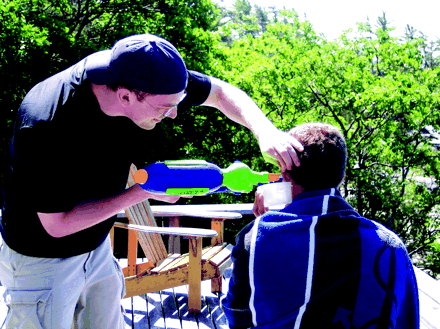
As described in the Canadian Medical Association Journal (Dec. 6, 2005), a man on vacation in rural Ontario experienced sudden, profound hearing loss. A family doctor on vacation in the same location was consulted and diagnosed the man as suffering from a buildup of cement-like ear cerumen. Lacking access to professional equipment for its removal, ingenuity was required. A child's Super Soaker Max-D 5000 proved to be the solution:
Midway through the second load's stream, wax particles began to run out of the ear. Just after starting the third load, a large plug of wax burst forth from the patient's ear. The 3 generations of family members present took turns admiring (or recoiling from) the specimen. The patient exclaimed in joy, "I can hear again!"...
The clinician operator of the device was impressed by the Super Soaker's ease of use for this procedure. Specifically, the ability to control a narrow, mildly pressurized jet of water was considered excellent. As well, the device only had to be refilled once or twice before the cerumen was removed from each ear. This is in contrast to his experience of requiring up to 10 or more refills of standard ear-syringing equipment. Using the Super Soaker in standard practice could then lead to decreased overall time spent on this procedure, resulting in shorter waiting times for patients through increased physician efficiency.
Posted By: Alex - Sun Mar 04, 2018 -
Comments (12)
Category: Medicine
Follies of the Madmen #348

Sadistic dentist, with an eye toward cultivating future patients, gives out candy.
Posted By: Paul - Tue Jan 23, 2018 -
Comments (4)
Category: Medicine, Advertising, 1920s, Teeth

| Who We Are |
|---|
| Alex Boese Alex is the creator and curator of the Museum of Hoaxes. He's also the author of various weird, non-fiction, science-themed books such as Elephants on Acid and Psychedelic Apes. Paul Di Filippo Paul has been paid to put weird ideas into fictional form for over thirty years, in his career as a noted science fiction writer. He has recently begun blogging on many curious topics with three fellow writers at The Inferior 4+1. Contact Us |




